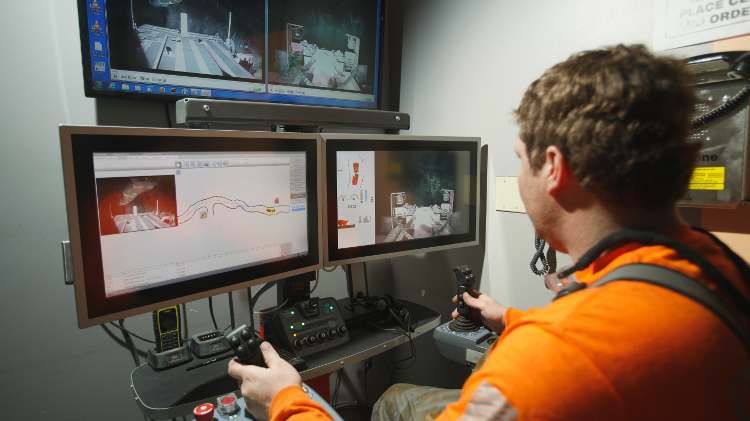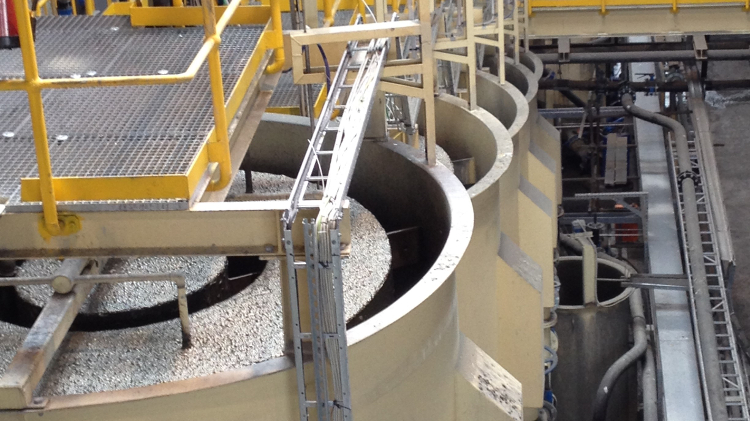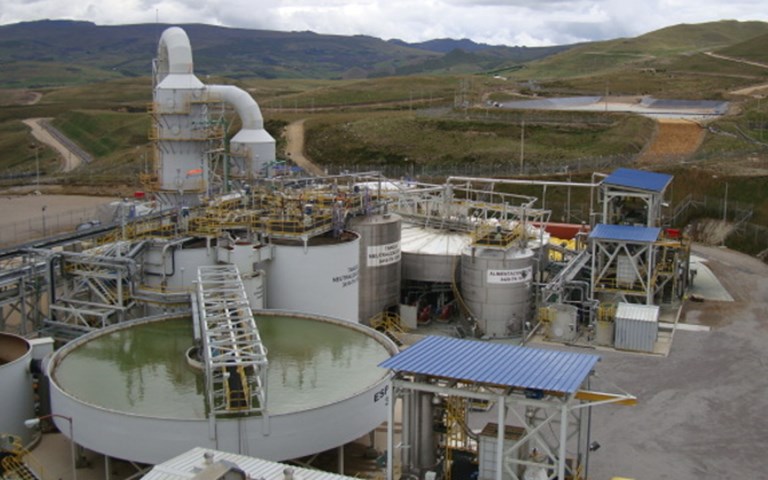Newmont Mining’s SART plant at its Yanacocha mine, originally installed in 2008, helped it recover 2.9 million lbs of copper concentrate from complex gold ores in 2015. Courtesy of Newmont Mining
A few years ago, Newmont Mining’s team at Yanacocha gold mine in northern Peru looked into the future and saw copper – a lot of copper. As with many gold mining operations in the last decade, Yanacocha, which produced its first gold bar in 1993, was getting closer to exhausting much of its oxide ore deposit. Digging deeper would lead to complex gold ores with very high copper content by 2015 – which meant leach solutions with copper levels as high as 700 milligrams per litre. The problem is that copper binds with cyanide creating a cyanide-copper complex solution. “You might have one part per million (ppm) of gold and 100 or 1,000 ppm of copper in the ore,” said process engineer Mike Botz, president of Elbow Creek Engineering. “In the back end of the plant, where they take the gold out of solution to ultimately make the gold bars, it can really interfere with the process.”
Preventing this requires adding more cyanide which leaves an excess cyanide-copper complex solution that may need to be treated chemically. This robs the process of valuable cyanide that would otherwise be recycled and reused. The expense of the lost cyanide, as well as the cost of chemicals to treat the solution, all equal higher operating costs.
Yanacocha, a joint venture between Newmont and Minas Buenaventura, however, had a potential trump card to deal with the copper. The mine had already installed a US$9.9-million sulphidization-acidification-recycle-thickening (SART) plant in 2008. This technology is designed to remove the copper from the solution and regenerate the cyanide through the addition of sulphide to precipitate copper sulphide as a solid precipitate. Yanacocha had built the plant to recover copper from the leach solution and to limit the concentration of copper in solution discharged into the environment. The plant was being used intermittently when the mine encountered ores with high copper content.
The SART plant was successful at removing the copper and silver from the pregnant leach solution prior to gold recovery, but the efficiency was inconsistent with lower levels of copper. In 2013, for instance, the plant removed 80 per cent of the silver but only 65 per cent of the copper. By 2015, the mine expected consistently higher copper contents and planned to operate the SART plant year-round. Newmont needed to ensure the SART plant was indeed a trump rather than a wild card and it needed to stabilize the copper recovery efficiency.
In 2011, Newmont’s metallurgists Gilmar Guzman and Leoncio Sevilla were put in charge of verifying the SART plant’s performance – and determining what, if any, changes were needed to ensure it would be effective with the high copper ores. They brought in Elbow Creek’s Botz, who had helped design the original plant and has worked on most of the SART plants in the world.
SART plants
In theory, SART plants are highly effective and can consistently remove more than 90 per cent of copper. And in fact, the process has been successfully tested in labs since the mid-20th century. Performance in the field is a different matter.
The SART plant at Yanacocha is an additional circuit added to its gold recovery plant. Its main components are reactor tanks and thickeners. Pregnant solution from the leach circuit with high levels of copper can be sent to the SART plant while clean solution from oxide ores are sent directly to the gold recovery process. The circuit consists of sulphidization and acidification where sulphuric acid and sodium hydrosulphide are injected along with recycled SART seed slurry to precipitate the copper as a copper sulphide. The solids are then removed from the solution in a thickener. Next, the cyanide in the acidic thickener overflow is neutralized with lime and calcium sulphate (or gypsum) is precipitated in a second thickener.
Preparing for the big copper rush
In 2012, Guzman, Sevilla and Botz developed a process simulation mass balance model for the entire mill at Yanacocha, including the SART plant, to evaluate how it would operate when high-copper ores are processed.
“We started by validating the model against actual operating performance,” said Botz. “If you can’t get the model to match reality, you can’t have faith going forward that it’s going to match.”
Then between May 12 and 26, 2014, the plant processed 263,000 tonnes of high-copper ore with an average of 17,600 tonnes per day (t/d) fed to the mill. The copper grade ranged between 500 and 2,800 grams per tonne (g/t). Copper removal efficiency in the SART plant ranged between 56 and 99 per cent, with a median of about 95 per cent.
“The main objective of the campaign was to show the SART plant could have high recovery,” said Sevilla. It certainly did, thanks to careful monitoring and the fact that they estimated the sulphide in the recycle seed and included this amount in the daily sulphide dosage.
“If there’s an excess of sulphide in the recycled seed slurry, combined with what is being injected, that’s a variation,” said Botz. “If it’s under-dosed, there is lower copper removal. If it’s overdosed, there are different theories as to what happens, but what I see is there’s often also a decline in copper recovery.”
There are currently no commercially available probes that can measure sulphide accurately. “Sulphide and cyanide are notorious with interfering with the analysis of one another,” said Botz. “All of it adds up to a fairly complicated control challenge.”
During the campaign, they relied on sampling for maintaining reliable sulphide dosages. “They’d measure copper in the leach solution and then calculate how much sulphide should go in and set their flow controller for that,” said Botz. “The problem with that is that by the time they collect the samples and take it to the lab and analyze it and get the information to the control room, four or five hours have passed. Now they’re operating the plant as it should have been operating four or five hours ago, so they’re always driving with their rear-view mirror and it works well sometimes and not at other times.”
Late in 2014, they decided to add an oxidation-reduction potential (ORP) probe in the reactor tank. “It helps,” said Botz. “It gives the operators another tool. Sulphide is a reductant. The ORP probe can measure the reduction potential and provide some empirical feedback. All an ORP can tell you is that it’s a reducing environment, but it can’t provide a concentration of sulphide in the solution.”
Today, “the operator takes samples every four hours to verify the controls,” said Sevilla. “But the plant is completely instrumented and we can see everything on the control room screen in real time. This allows us to react very quickly if there are variations in the plant.”
Throughout 2015 Yanacocha’s SART plant worked continuously, achieving an overall copper recovery efficiency of between 80 and 90 per cent, which amounted to 2.9 million lbs of copper concentrate with 10 per cent silver.
While SART technology still needs work, and today it takes a relatively large amount of copper to justify the cost, Botz said he believes that in the future, as more gold mines explore high-copper deposits, they will consider SART as an option.
For Yanacocha, however, had the campaign proven unsuccessful, it would have been disastrous. “We had no other option,” said Sevilla. “We would not have been able to produce the gold.”




